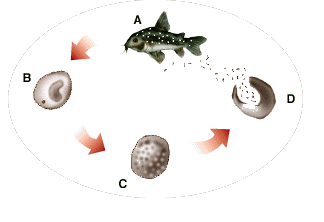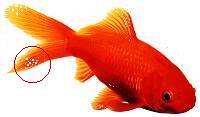Aquarium Manual
Controlling Ich

Ich, also called white spot disease, is one of the most common protozoan infections affecting aquarium and pond fishes. This brief overview of the life cycle will help the aquarist and pond keeper understand more about the problem and assist them in properly treating their fishes.
The term "Ich" comes from the generic name Ichthyophthirius of the species multifilis, which is the freshwater form of white spot disease. The marine protozoan causing white spot disease is Cryptocaryon irritans.
The most common way of diagnosing ich is by close observation of the infected fishes. The presence of small, (.5 to 1.0 mm) white dots scattered about on the fishes' skin. However, this is not always proof that the fish is infected with ich as several other infections can have a similar appearance. Proof positive can be obtained by removing one of the spots and observing it under a microscope. Ich has a small micronucleus and a prominant crescent-shaped macronucleus.
Ich Frequently Comes with New Fish or Plants
Ich is most often introduced into the aquarium or pond by adding new fishes or aquatic plants. The intermediate stage of the disease cycle, which have only recently attached themselves to the host plants or fish will not be readily visible. In fact they are very stealthy invaders.
It is good aquarium and pond keeping practice to isolate any new fishes for at least four days under close observation. For tropical fishes, maintain a temperature of around 75° F (24° C). Check carefully for the presence of any tell-tale white spots appearing on the skin of the fishes and treat them accordingly. If no white spots are observed on tropical fishes within four days at this temperature, they can be moved from isolation. Remember, fishes maintained at cooler water temperatures (such as pond fishes) will require longer isolation times because it will take longer to progress to and through the visible stage of ich in cooler water than in warmer aquariums.
Stages of Ich
The most dangerous stages of Ich are carried out within the host fishes' skin (seen in the picture below).
The first stages on the skin are called trophozoites, and they are highly resistant to drug therapy. They are not actually visible to the naked eye. The cycts surrounding the Trophozoites look like little white spots on your fish and protect the ich from tratment.
Trophozoites mature into trophonts and leave the host fish, falling to the bottom of the aquarium or pond where they continue the reproductive cycle. They mature and release from 200 to 1,000 tomites.
 The tomites move about looking for a host, which they must find within 2 to 3 days at 75° F (24° C) or they will die. (Cooler temperatures will prolong their viable life). Once the tomite attaches to the host (your fish), the cycle begins anew.
The tomites move about looking for a host, which they must find within 2 to 3 days at 75° F (24° C) or they will die. (Cooler temperatures will prolong their viable life). Once the tomite attaches to the host (your fish), the cycle begins anew.
Once comfortably established on a host fish, Tomites wreck havoc on the health of the host. Fish can die from respiratory distress caused by so many parasites in their gills, from skin punctures that upset the fish's ability to regulate water and nutrient intake, or from secondary infections of bacteria and fungi that attack the open wounds.
It is this free-swimming stage of tomites that is most vulnerable to treatment.
Chemical Treatments for Ich
Various treatments for Ich are tried and true. Malachite Green Formaline and Copper have been around for decades. Both have been shown effective. However, both have serious drawbacks, especially for scaleless fish and invertebrates. I prefer to look at mechanical options that have almost no drawbacks for any species.
Mechanical Treatments for Ich
Raising the temperature of the water slightly will actually speed the Ich maturation process, giving you a chance to attack any latent tomite stage faster. 86° water retards ich reproduction and may actually kill Ich tomites. Freshwater tropical fish can usually tolerate a temperature from 86° to 89° for a period of 10 days if the temperature is raised and then lowered gradually (about 1° per hour).
Use a UV Sterilizer. Uv sterilizers literally "sunburn" the free-swimming tomites to death. Used properly, neither ich tomites nor many strains of algae cells can prosper in your tank.
Use a Micron or Diatom Filter. Because the swarming tomites are approximately 30 microns in size a good diatom filter will reduce the number of free-swimming tomites to nothing. If you raise the temperature of the tank to encourage faster maturation, you can catch the tomites and literally discard them before they have a chance to rreproduce. Use it daily, and clean the filter cartridge with hot or boiling water between daily uses.
It should be reiterated that you must treat (by whatever means you choose) for longer than the visible white spots are apparent. Since the "invisible" stages can thrive out of view, you must treat until you are confident that all stages have matured and been dealt the death blow.